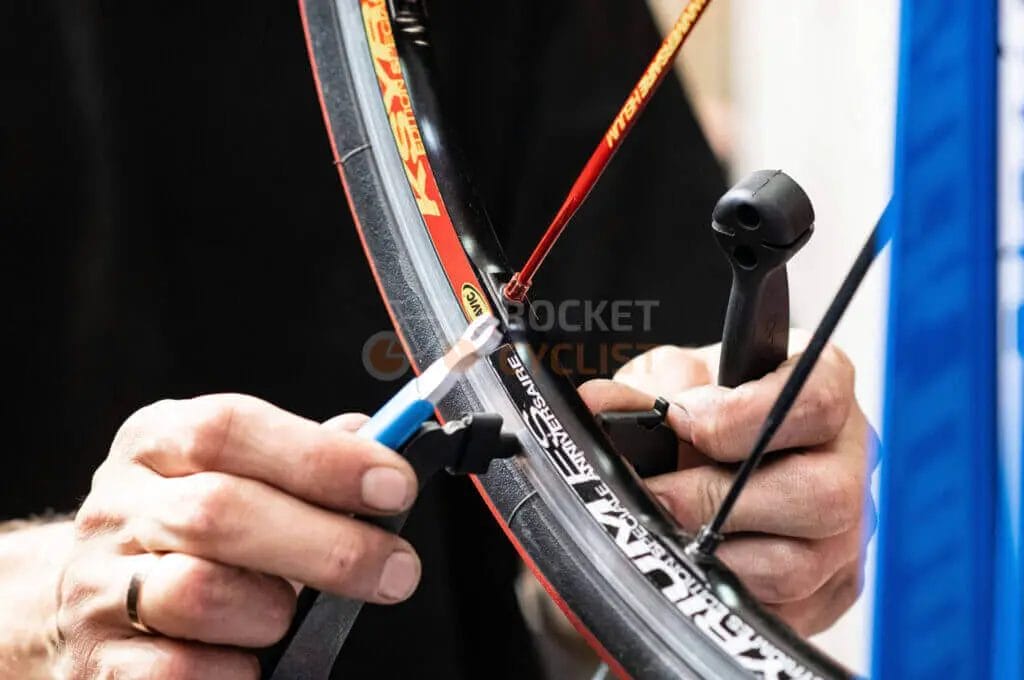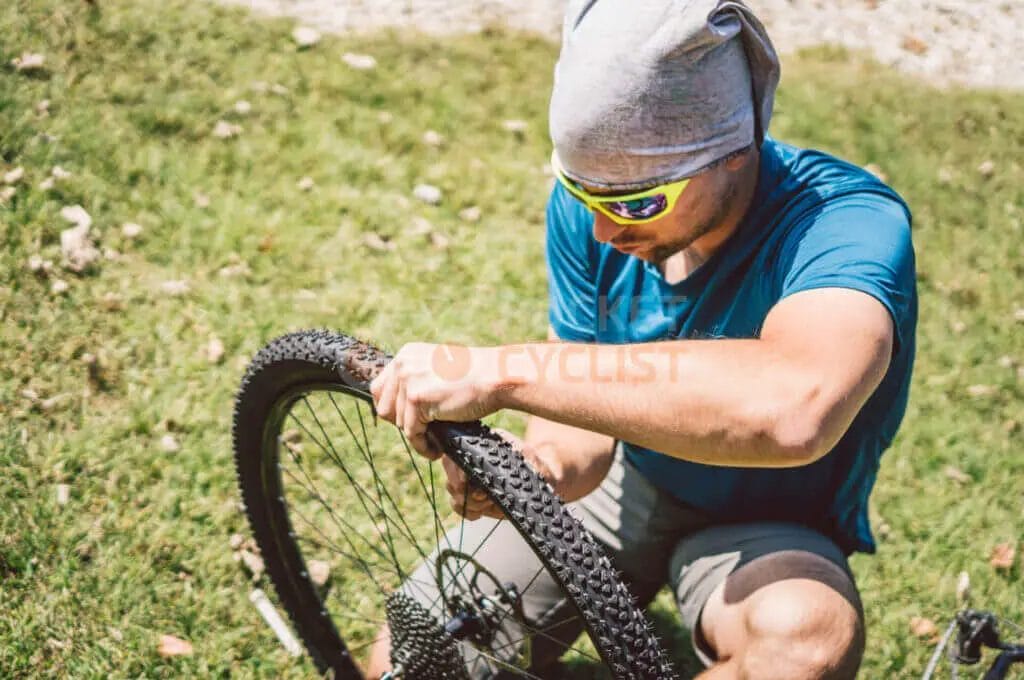Last Updated on April 10, 2024 by Vinson Lozano
Bicycling, a beloved activity for many, requires a fine-balanced and well-maintained machine. Among the vital components of a bicycle, rims play a significant role in ensuring a safe and comfortable ride. Particularly when it comes to aluminum bicycle rims, addressing damage timely is crucial because the state of disrepair can hinder your bike’s performance.

The Importance of Bicycle Rim Maintenance
Maintaining your bicycle rims is not only essential for a smooth riding experience but also for safety purposes. A maintained rim helps the tire to keep its shape, support the bike’s weight, and handle the forces from braking and acceleration. Specifically, when you have aluminum rims, which are admired for their lightweight and performance attributes, certain types of damage could significantly affect these features if not addressed properly.
Common Types of Bicycle Rim Damage
Several common types of damages usually occur with bicycle rims. They include:
- Bent Rims: This typically happens due to a collision or riding over large potholes. In many cases, bent rims can be straightened by a skilled technician.
- Cracked Rims: It largely occurs due to the usage of a narrow tire on a wide rim or over inflation of the tire.
- Brake Track Wear: With time and use, the rim’s brake track can start to wear down. This happens more commonly on bikes that do not have disc brakes.
Each type of damage has its own set of solutions, and luckily, with modern technology and skilled technicians, many aluminum rim issues can be fixed. However, the complexity and success of the repair depend on the severity of the damage and the expertise of the repair technician. This guide will provide a closer look at whether and how such damages can be repaired in the following sections.
Assessing the Damage
To determine if your aluminum bicycle rims can be repaired, it’s essential first to assess the type and extent of the damage.
Signs of Damage to Aluminum Bicycle Rims
1. Visible Dents and Bends: The most obvious signs of damage to aluminum rims are visible dents and bends. These deformations can affect the bike’s performance and safety.
2. Consistent Tire Deflation: If your tires frequently lose air, this could indicate a problem with the rim, such as cracks or bends, that might require repair.
3. Wobbling or Vibrating Ride: If the bike wobbles or vibrates while riding, it could be a sign that the rims are warped or damaged.
Determining the Extent of the Damage
1. Visual Inspection: Start by performing a visual inspection of the rim. Look for any dents, bends, or cracks that could potentially affect the rim’s structural integrity.
2. Rotational Inspection: Spin the wheel to see how it behaves. A healthy aluminum rim should spin smoothly, without any wobbling or deviations.
3. Tire Inspection: Check if the tires are seated evenly and securely. If the tire frequently comes off the rim or deflates, it can indicate a problem with the rim.
| Signs of Damage | Diagnostic Process | Repairability |
|---|---|---|
| Visible Dents and Bends | Visual Inspection | Depends on severity |
| Consistent Tire Deflation | Tire Inspection | Yes, if not severe |
| Wobbly or Vibrating Ride | Rotational Inspection | Depends on severity |
In conclusion, while minor damage to aluminum bicycle rims can often be repaired, severe damage may require a replacement. Always have your bike inspected by a professional if you’re unsure about the extent of the damage or the appropriate course of action.
Professional Repair Options

When it comes to repairing aluminum bicycle rims, seeking professional assistance may be the best course of action. Expert bike mechanics have the knowledge, tools, and experience necessary to ensure the repair is done correctly and safely. Let’s explore the advantages and disadvantages of professional bicycle rim repair:
Pros and Cons of Professional Bicycle Rim Repair
Pros
- Expertise: Professionals have the necessary skills and knowledge to repair your bicycle rim correctly.
- Tools: They have access to specialized tools that may be required for the repair process.
- Safety: They can ensure the repaired rim is safe to use and won’t compromise your riding safety.
Cons
- Cost: Professional services can be expensive.
- Time: Depending on the extent of the damage, the repair process can take some time.
Here’s a brief comparison of the pros and cons:
| Pros | Cons |
|---|---|
| Expertise | Cost |
| Access to specialized tools | Time |
| Safety assurance |
Choosing a Reliable Repair Service
Choosing a reliable repair service is crucial for ensuring the longevity and safety of your bicycle rim. Be sure to research the reputation of the service, read reviews from other customers, and inquire about their experience with aluminum rims before making a decision. The mechanic’s qualifications and the shop’s warranty policies should be considered as well. Remember, the cheapest option may not always be the best option; quality and safety should never be compromised.
Overall, while it is possible to repair aluminum bicycle rims, it is usually best to involve professionals to assure your safety while riding. After all, a well-maintained bicycle ensures a smoother, safer ride.
DIY Repair Techniques

When it comes to repairing bicycle wheels, particularly aluminum rims, there are some DIY methods that can help fix minor damages.
DIY Methods for Minor Rim Damage
1. Using a Spoon:If the rim damage only looks like a mild dent or bend, sometimes the rounded back edge of a steel spoon can suffice. You have to apply pressure gently and gradually to avoid causing further harm. Safety goggles and gloves are recommended while working with metal.
2. Adjustable Wrench: An adjustable wrench can also be a handy tool. It works best when the damage is more severe than a spoon can handle, provided the deformation is not too extensive.
3. Wheel Truing Stand: For an even more comprehensive DIY method, a wheel truing stand can be used, which allows you to straighten the wheel and adjust the rim’s alignment for a smoother ride.
Step-by-Step Guide to DIY Rim Repair
Here’s a simple guide to DIY aluminum bicycle rim repair:
Step 1: Firstly, identify the damaged area on the rim. This is crucial as it’s important to concentrate your repair efforts on the correct spot.
2: Now, depending on the severity of the damage, decide whether to use a spoon, an adjustable wrench or a wheel truing stand for repair.
3: Carefully apply pressure on the damaged area using the selected tool. In the case of the wrench or the spoon, it’s a gentle, controlled pushing or bending motion. With the wheel truing stand, you’ll use the indicators and adjusters built into the stand to gradually correct the rim’s alignment.
4: Repeat this process as necessary until the rim appears straight.
Remember, these methods are suitable for minor damages. If the rim is severely bent or cracked, it’s safer to replace it or seek professional help. Safety should always be a bicycle rider’s top priority.
Limitations of Repairing Aluminum Bicycle Rims

Bicycle enthusiasts know that bicycle rims made of aluminum can be prone to damage over time. Despite this, not all damage means replacement, as some can be repaired. However, it’s crucial to understand the limitations and risks associated when it comes to repairing aluminum bicycle rims.
When Not to Repair Aluminum Bicycle Rims
1. Structural Compromise: As a general rule, once the integrity of the aluminum rim has been seriously compromised, it is unwise to attempt repairs. Catastrophic failure such as cracking represents a point-of-no-return, as these rims could pose a safety risk when used again.
2. Constant Repairs: When a rim has undergone multiple prior repairs, further attempts may not be effective. The repetitive process of re-straightening and re-shaping could weaken the rim, making it less durable over time.
3. Extensive Damage: Insurmountable dings, bends, or warping that interfere with the functionality of the brake system are too damaged to be repaired efficiently.
Understanding the Risks Involved
While minor damages like small dents or scratches can often be fixed, attempting to repair serious damages may lead to the increased risk of rim failure during rides which is dangerous. It could cause a sudden loss of control or even a complete wheel collapse.
Straying away from professional advice that recommend replacing instead of repairing damaged rims can also void the manufacturer’s warranty. As a result, when faced with the cost of potential repairs versus replacement, consider safety, functionality, and long-term endurance first and foremost.
In conclusion, it’s within the realm of possibility to repair aluminum bicycle rims. But in case of severe damage, it’s often safer and more cost-effective in the long run to consider a replacement.
Alternatives to Repairing Aluminum Bicycle Rims
If your aluminum bicycle rim is damaged, you might be pondering whether to repair it or flat out replace it. While both options have their pros and cons, the ideal choice ultimately depends on various factors such as the extent of the damage, the cost implications, and the effectiveness of a repair.
Replacing the Rim vs. Repairing the Rim
Repairing the rim: Minor damages on an aluminum bicycle rim, such as small dents or bends, are typically repairable. A professional bike mechanic could use specialized tools and techniques like the press method or the spoon method to restore the rim to its original shape.
Replacing the rim: However, if the rim has suffered significant damage – think large dents, severe warping, or cracks – the recommended approach is replacing the rim. This could provide more durable results and prevent future accidents caused by a compromised rim.
Below, you’ll find a quick comparison between the two options:
| Repairing the Rim | Replacing the Rim | |
|---|---|---|
| Level of damage tolerated | Small dents or bends | Large dents, severe warping |
| Cost | Typically cheaper | More costly |
| Result | Temporarily fixes the problem | Offers a permanent solution |
Considering the Cost and Benefits
When debating between repairing and replacing your aluminum bike rim, it is crucial to weigh the costs against the benefits. While repairing a rim could be less expensive upfront, keep in mind that it is often a temporary solution and the damaged rim may require further repairs down the line. On the other hand, replacing the rim is more costly initially but could save you money in the long term due to its durability.
Regardless of the path you choose, ensure you consult with a bike mechanic to make an informed decision that prioritizes both your safety and satisfaction.
Maintenance Tips to Prevent Rim Damage

When it comes to maintaining the health of your bicycle, one area that often gets overlooked is the rims. If your aluminum rims become damaged, it can affect your ride’s smoothness and can even lead to safety issues. Fortunately, with proper maintenance and care, you can prevent unnecessary damage and extend the life of your bicycle rims.
Proper Bicycle Maintenance to Avoid Rim Damage
It’s essential to check your bicycle’s rims regularly to catch any minor damage before it becomes severe. Look for cracks or deformities and check the alignment regularly. Misalignment can occur due to various reasons, such as severe jolts, bumps, or accidents, and it is a common cause of bicycle rim damage.
Keeping the rims clean is another crucial preventive measure. Over time, dirt and debris can accumulate inside the brake pads, which can scratch and erode the rims when braking. Regularly cleaning the rims and brake pads with a mild soap and water and a soft brush can help prevent this.
Tips for Prolonging the Lifespan of Your Bicycle Rim
Here are some tips to prolong the lifespan of your aluminum bicycle rims:
- Avoid Potholes and Obstacles: This might seem obvious, but hitting potholes or riding over sharp objects can severely damage rims. Always try to steer clear of any obstacles on the road.
- Right Tire Pressure: Maintaining the correct tire pressure can help protect the rims from damage. Over-inflated or under-inflated tires can cause the rims to bend or warp over time.
- Ride Gently: Excessive force when riding can cause the rims to flex beyond their capacity, leading to damage. Always try to ride smoothly and avoid any unwarranted aggression, particularly when going over uneven surfaces or off-road terrain.
By employing some simple maintenance tips and riding habits, you can extend the lifespan of your aluminum bicycle rims and keep your ride running smoothly. Remember, prevention is better than repair, especially when it comes to bicycle rims. If you notice any significant damage to your rims, it might be worth considering a replacement for your safety and ride quality.
Conclusion
In conclusion, it’s crucial to remember that the integrity and safety of your ride depend on the condition of your bicycle rims. Therefore, the question of whether aluminum bicycle rims can be repaired is not as straightforward as it may seem.
Factors to Consider When Deciding to Repair or Replace Aluminum Bicycle Rims
1. Extent of the Damage: The first and foremost factor to consider is the level of damage to the rim. Minor dents or bends could often be repaired with some specialist tools and professional know-how. However, if the rim has a significant crack or if it’s been damaged in multiple places, a replacement is usually the safest option.
2. Quality and Age of the Rim: Older rims or those of lower quality might not be worth the repair cost. The materials may have degraded over time, impacting the rim’s structural integrity even after the repair. In such cases, investing in a new, high-quality rim might be the most cost-effective and safe choice.
3. Cost: Often, the cost of repairing a significantly damaged rim can approach or even exceed the price of a brand new one. Thus, if the repair cost is high, replacing the rim could be the more economical decision.
Here’s a small table summarizing these points:
| Factors | Repair | Replace |
|---|---|---|
| Extent of the Damage | Minor | Severe |
| Quality and Age of Rim | High/New | Low/Old |
| Cost | Lower | Higher |
In conclusion, while it’s technically possible to repair an aluminum bicycle rim, whether or not you should depends on several factors: the extent of the damage, the quality and age of the rim, and the cost. Always prioritize your safety when making this decision and consult with a professional if in doubt.


